Euromold 2014 - Everything you need to know about the prospects of 3D printing
2014 was very eventful. Fortunately, far from not only in a political sense, but also around our subject matter - additive technologies and 3D printing. Traditionally, several dozens of conferences and exhibitions take place in a year, in which all participants of the world market, in one form or another, talk about their achievements.
At foreign exhibitions I was in the role of a guest, in Russian as a participant - the company 3DPrintus . The first two exhibitions - Inside3DPrinting in New York and 3D Printshow in London are focused primarily on companies providing 3D printing, scanning services, creating useful software, and so on.
')
The current exhibition Euromold in Frankfurt, which will be discussed, is the largest in the world and unites not only participants of the market of additive technologies, but also traditional production. At Euromold, they always announce and demonstrate new equipment and professional software solutions.
In this publication, I don’t set myself the aim to tell in detail about which models of 3D printers or materials presented by manufacturers (this information is easy to find on thematic sites). First of all, I will share industry insights and conclusions that I made while communicating with its representatives. And I will try to answer the question: Where is the development of technology and its application in the real world .
Popularization
Formally, many have heard about 3D printing, but the use of technology is still very far from the mainstream market. This is due to such obstacles as knowledge of materials, the presence of a 3D model, the non-obviousness of applying technology to customers' tasks. Well, of course, the inertia of people to everything new as a whole.
Some companies in the market are trying to solve this problem. Each does it in its own way.

The company Artec Group, launched its service Shapify , allowing anyone who wants to instantly make their 3D-scan and after a while get their miniature copy in color. Artec collected a large booth with lighting and scanners in a circle, which is used to make a 3D scan of a person.
As you can see, Shapify is not the only solution with its 3D booth ( Botscan were on the other side of the same pavilion), however, as far as I know, it is the most successful from the point of view of cloud infrastructure, support for rendering and fixing models, which makes life much easier who wants to do business on this.
The solution itself is sold on a turnkey basis and you can take a chance and run your business by finding the right combination of space, traffic from people and reliable 3D printing partners. Shapify franchise prices here .
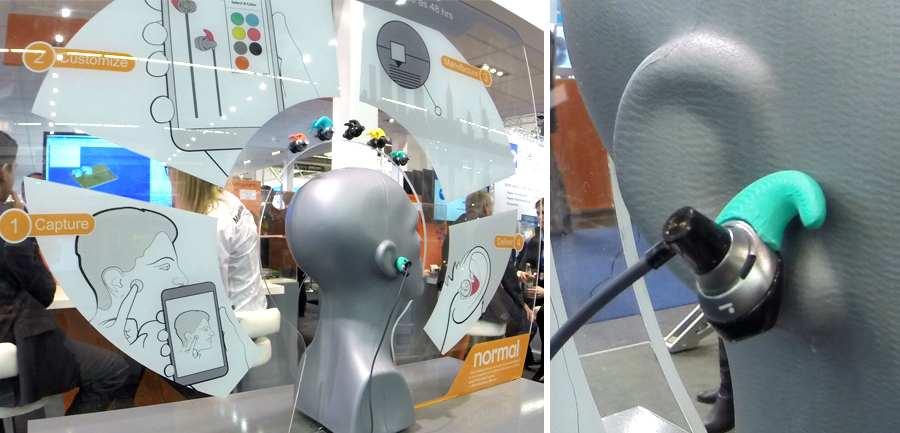
Normal startup, widely known in narrow circles, offers to look at and touch their product - a customizable headphone pad, made specifically for the client's ears. And they, as we know, are very individual.
This is one of the latest examples of the combination of traditional mass production technologies and the personalization of 3D printing.
In my opinion, quite a good solution and in cooperation with Stratasys it will go actively to the masses.

Low-cost (almost) Blueprinter printers, printing models using Selective Thermal Sintering (SHS) technology, have been on the market for several years, and lately their price has increased from $ 10,000 to $ 25,000. However, this is the most affordable printer that allows parts in a small chamber (200 x 157 x 140 mm) from the most popular material - polyamide.
Companies providing rapid prototyping services are also not interested in promoting technology. Instead of placing complex engineering solutions or prototypes, they show beautiful final objects, pleasant in appearance and touch. Thus, they do not show the process and their services, but the result and joy for the client.
This is a very useful approach that conveys to visitors the idea that technologies are close to ordinary people and are used in their interests.
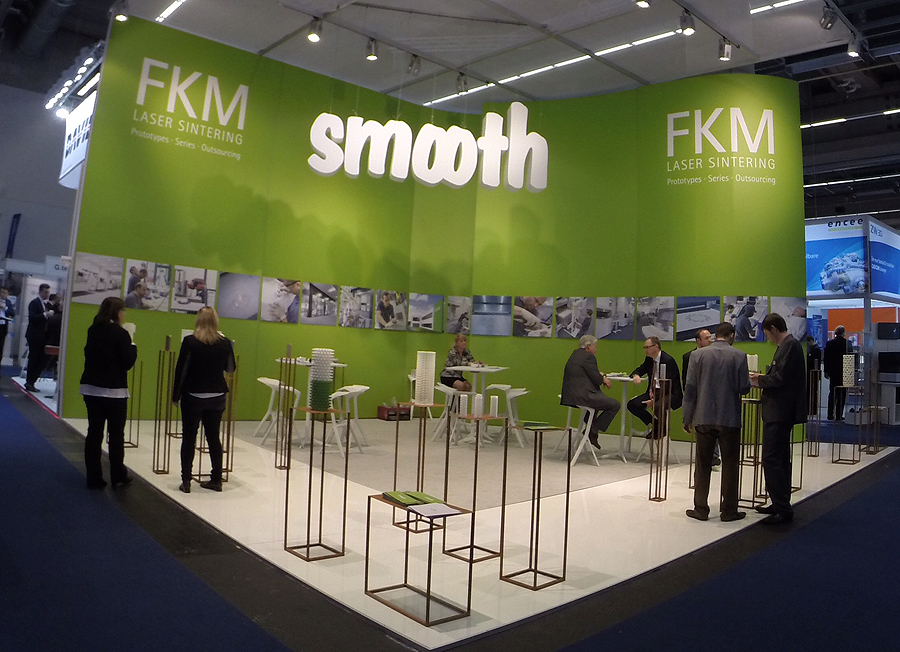
From the point of view of the most popular material for 3D printing (after the "home" ABS / PLA), the absolute leader is polyamide (nylon). Productions providing 3D printing services buy EOS machines in large quantities and build their business on the technologies of this manufacturer. Moreover, the recently announced porcelain material will also be produced using the same material.
3D printing which is not spoken on TV
It so happened that all major innovations and the so-called third industrial revolution in 3D printing is taking place outside the focus of media attention. Only specialists very close to the subject know about all the new materials, printers and capabilities. The rest of the people (including interested customers) remain completely unaware and therefore the introduction of technology and widespread commercial application among small and medium businesses, as well as B2C, is slow.
Personally, I am extremely interested in disseminating this information to the masses, but without excessive cleverness and excessive immersion in the subject. Because the most interested will be able to find the information themselves, and for those to whom 3D printing will help solve their own problems or business problems, you need to know only about realistic opportunities.
All the rest should be done by services that create a “bridge” between the needs of customers and production capabilities.
Big cars - great opportunities
Euromold is the very place where the concentration of professional and industrial 3D printers exceeds the limit. All manufacturers try to bring here the very best, big and incredible. It is here that major deals are made on the procurement of such printers.
For example, this year I saw a very large number of Chinese (and even some Indians) who were actively discussing the issue of purchasing printers, which, of course, indicates that China does not sleep not only in mass production, but also soon in 3D printing .
One of the brightest stands, around which all days were the most people - is the stand of 3D Systems , one of the leaders in the production of 3D printers.
Alone, the employees of 3D Systems in their outfit were 98 people. And almost every one of them was constantly busy communicating with many interested visitors.
The company brought all its latest printers printing from gypsum polymer (full-color gypsum), photopolymers (high-precision plastics), metals (titanium, cobalt-chrome, steel) and polyamide (durable and flexible plastic) on the stand.
One of the flagships is the SLA ProX 800 printer, which makes very large parts from high-quality and accurate photopolymer, which is suitable for the production of prototypes of car parts.
Also, the Prox 500Plus SLS (Selective Laser Sintering) printer allows the company to actively compete with the leader in the field of powder plastic printing, EOS, which printers are currently used in the vast majority of companies involved in prototyping from these materials.
And, of course, the most impressive is the metal 3D printer ProX 400, weighing several tons, allowing you to make very large parts, up to 500x500x500 mm in size. The model of the metal rocket speaks for itself.
It is worth mentioning that some of the cars brought to the exhibition are just shells, with no filling inside. To impress guests, but not to show (and not to drag) too much.
The following is a huge booth and leading company - Stratays .
The company decided to beat its entire booth in the aviation category: here and the fuselage of the aircraft with seats and business class on the second floor and many other elements.
Stratasys printers are considered among the leaders in the field of plastic printing, which the company proves by demonstrating the printing capabilities of both very large parts (pictured above) and medium ones (using its own multi-material multi-color printing technology).
Here, when printing, several colors of plastic are used at the same time, both durable and flexible (rubber-like), which in fact makes it possible to get very impressive results.
There are certain disadvantages in technology, such as: high cost of materials (in comparison with full-color plaster), a restriction on the color palette and the need to change the color palette if you plan to diversify the color of your object.
In general, Stratasys updated almost all of its equipment fleet and actively competes with Projet 660 full-color gypsum printers from 3D Systems and with the scale of plastic printing with SLA printers from the same 3DS.
However, in my opinion, the most important strategic assets for Stratasys are the companies Grabcad and Makerbot (+ Thingiverse) purchased by him - this is what will allow the company to give its customers a full range of features and services around 3D printing.
Using the power of the collaborative online platform Gradcad and a huge community of engineers, as well as the largest archive of 3D models of Thingiverse, Stratasys makes the purchase of their equipment even more attractive. In fact, they are building a very proper eco-system. This is a great contribution to future development!

The third industry leader is the German company EOS . A series of printers with the designation EOS P (110, 396, 760, 800) is used in the overwhelming majority of popular 3D printing services and polyamide products (both prototypes and final products) are considered the best in terms of price / quality ratio.
At the exhibition, the company demonstrated its EOS M400 metal printer with a 400 x 400 x 400 mm camera and the ability to print from cobalt-chrome, steel, titanium and other metal powders.
EOS uses for its printers a very wide range of materials that are very well located at the company's stand. Two small videos demonstrate this:
And for those who are interested in what the material itself looks like in its original form, the company has prepared test tubes with powders:
However, one of the most interesting releases of the company this year is a partnership with Cooksongold , one of the oldest manufacturers and suppliers of equipment and materials for jewelers in the UK.
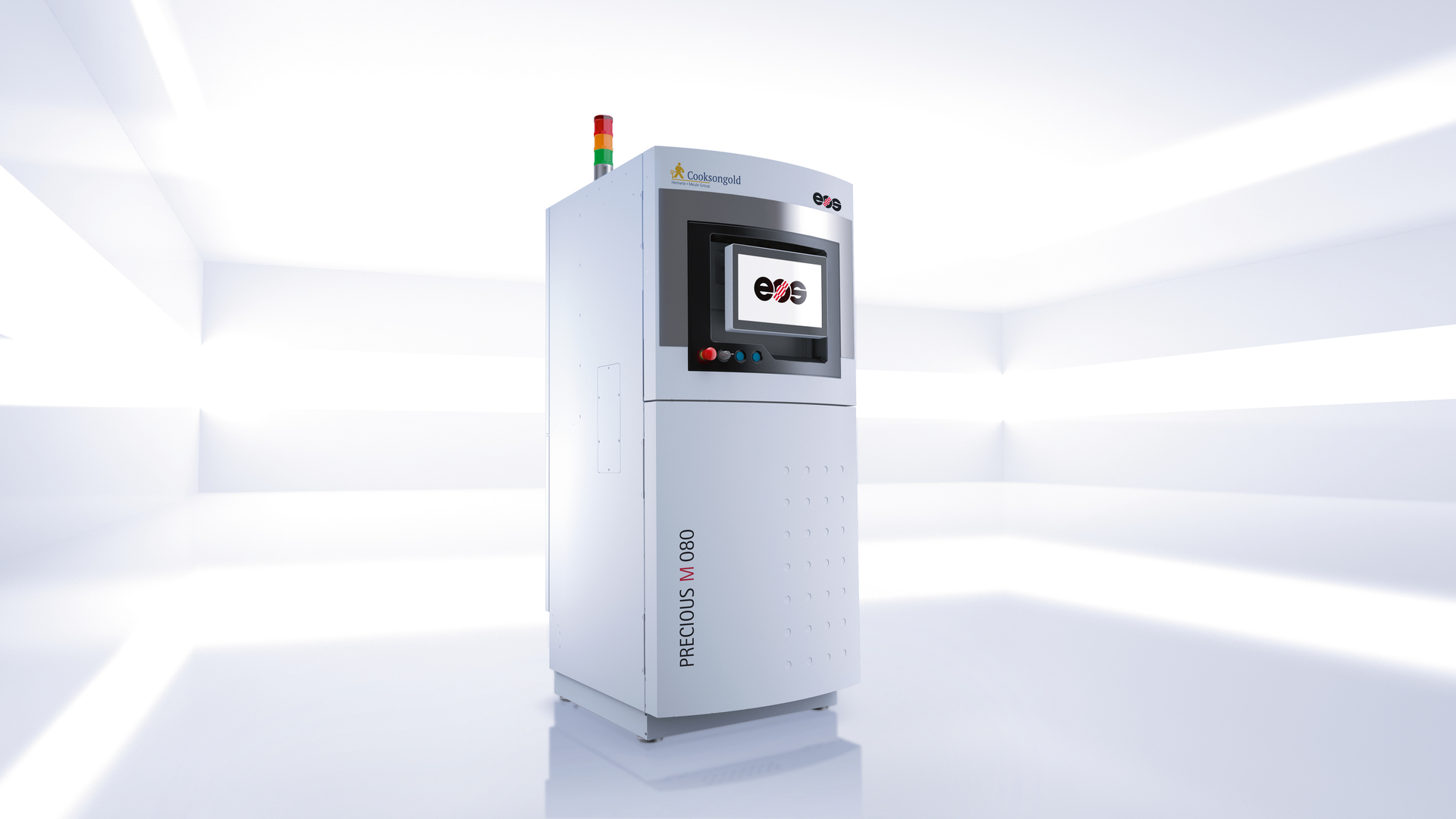
Cooksongold and EOS have created a 3D printer for printing from precious metals. Cooksongold developed powders of 18k gold (pink, yellow, white) and with the help of the printer M080 produces precious products of complex shapes that are not under the power of traditional casting.
A representative of the company David Fletcher told about the possibilities of a printer for printing jewelry. Here are the main points that I would highlight:
- no design restrictions
- complex forms not available in traditional casting
- thin walls of products
- lightweight, hollow products
- making permanent connections
- short production time, from 4 hours + 1.5-2 hours for processing
At the same time, 99% of unused powder is reused in production.
David demonstrated several product samples.
This is a suspension inside which there is a rotating element. All printed at once.
All parameters for manufacturing the suspension can be seen below:
And this is a bracelet with segments. Also printed at a time, disconnected.
All products are manufactured using the SLM technology — selective laser melting. Final products require jewelry processing, however, as well as when casting. However, the advantage of the technology offered by Cooksongold and EOS is obvious.
This method of production is suitable for exclusive jewelry, as well as individual products manufactured in batches. 3D printing on this technology in the next few months will be available on our website .

Next, let's talk about ExOne , its technology allows
create two types of products: sand molds for subsequent casting and direct printing from steel of different grades.
Most of all, the company is known for its ability to print from steel with bronze with various methods of post-processing, resulting in very unusual products.
Also, it should be noted the huge contribution of ExOne to the production of sand molds for casting metals. This technology is very actively used in the automotive, air and military industries. One example of how the result of producing a part looks after the use of a burnable form is as follows:
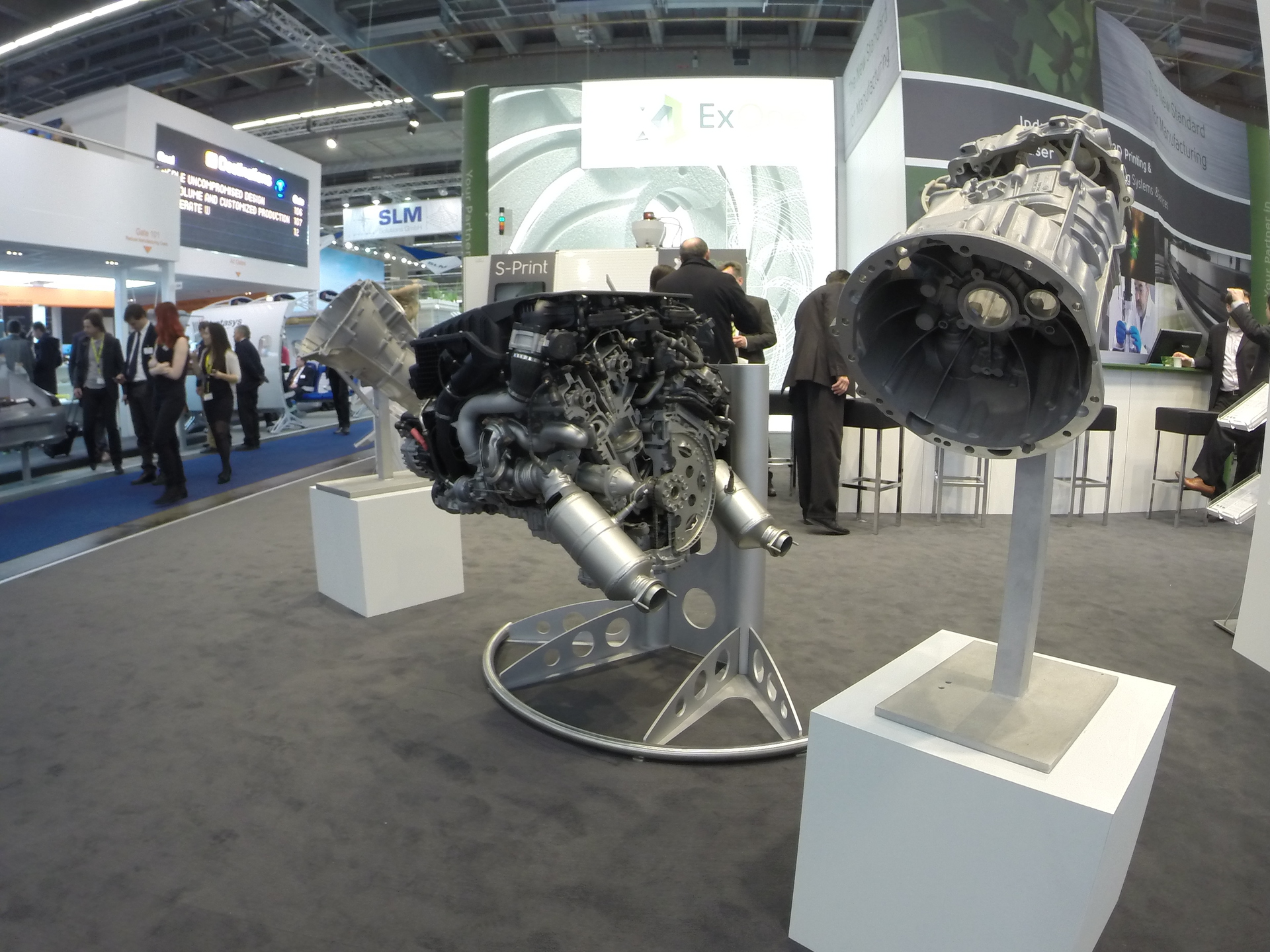
Distinguished and the company SLM (manufacturer of metal printers). At Euromold, the company demonstrated a printed lunar rover Asver R3C, which next year will go to the moon!
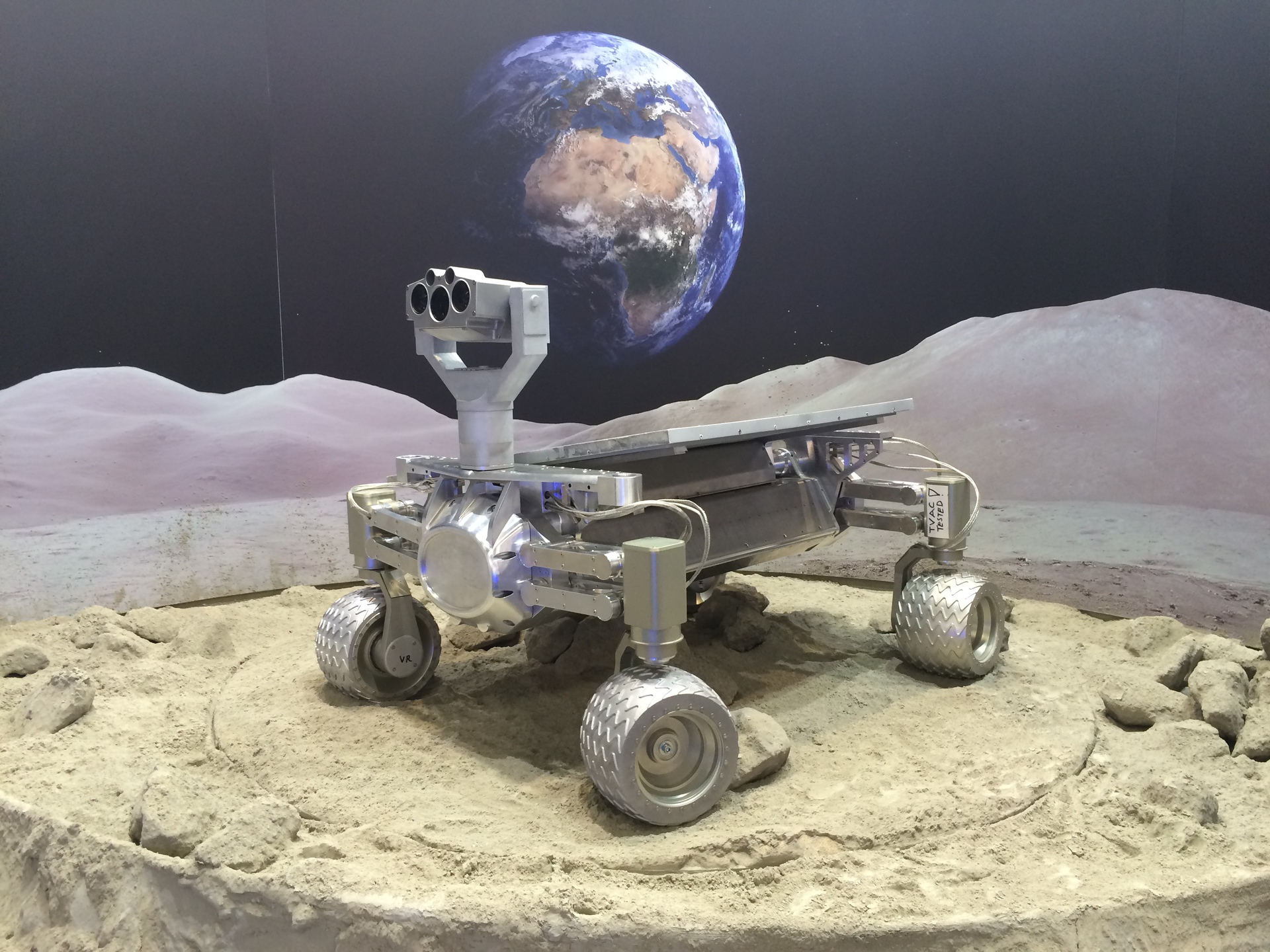
An overview of all those who contribute to the development of 3D printing would not be complete without a brief account of Arcam , a manufacturer of industrial 3D printers using EBM (electron beam melting) technology, which allows to manufacture high-precision titanium products.
The company mainly works for the aerospace and medical (orthopedics) spheres. It is precisely its solutions that allow solving problems of reducing the weight of structural elements of rockets (as an example) and the creation of orthopedic prostheses and inserts adapted for a specific person.
Another very important, but slightly less noticeable player in the market of additive technologies is Reninshaw , which presented its new metal printer EVO Project at Euromold.
Printer manufacturers have a strong focus on fully automating all manufacturing processes and minimal operator intervention. Printing, processing powder, cleaning, recycling - all controlled by the printer. At the moment, the printer is sharpened for one material. This is a very interesting example of the desire of the sphere to improve the automation of processes, as now it is a problem.
Those who expected to see the newly announced HP printer were disappointed. Since the printer is still far from perfect, it would be wrong to represent it at Euromold.
It is rumored that the printer uses the old technology of full-color printing, which was already once used by the company 3D Systems (the pioneer of full-color printing). And the products that are now being manufactured on a HP 3D printer are still very fragile. In general, we are waiting for this printer no earlier than 2016.
Summing up on printers and materials, I would like to once again note that the scope of application of 3D printing is much wider than it seems at first glance. And now the main task is to reduce barriers to the use of these technologies for businesses and customers.
I am convinced that only transparency and IT systems will help bring all these solutions to the widest market. And it is necessary to invest effort and money in the creation of such infrastructures.
Trends
In conclusion of the article, I would like to share my opinion on where the technology is moving, what will change in the near future and how this will affect the massive introduction of 3D printing in business and various industries.
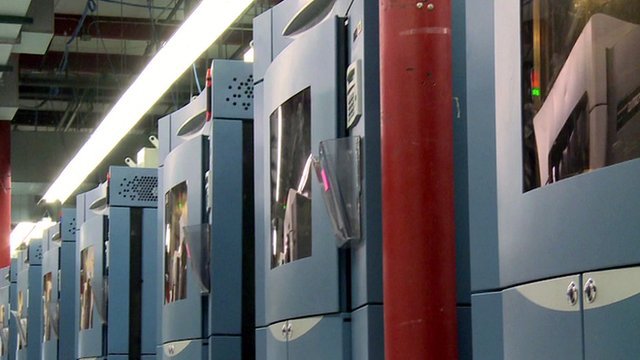
Automation and conveyor
One of the most important trends for the next 2-3 years will be the gradual transformation of industrial 3D printers into automated production systems. Then the efforts of the technologist / printer operator will no longer be directed to constant new downloads, cleaning models, sifting powder, and so on.
Instead, a fully automated 3D printer system will do most of the operations on its own, without human intervention. This allows us to greatly automate the processes that are now done by hand.
Such a trend is a consequence of “requests” from such large customers as General Electrics , which requires printer manufacturers to create systems for the production of not single products using 3D printing, but the adjustment of their mass production.
Considering the advantages of 3D printing over traditional productions, the emergence of the possibility of mass production of products will take technology to a whole new level.
Companies such as 3D Systems, EOS and Stratasys actively interact with large customers to create such systems.

Optimization
The second important trend is the creation and development of automated software that allows you to optimize the weight, cost, design of any objects made using 3D printing. The generation of various internal structures (inside the 3D model) allows you to set and change the strength characteristics of the products, make them completely flexible, springy, ventilated, and so on.
I want to point out exactly that the implementation of such structures at the level of online software, will soon allow to avoid errors in the design, as well as simplify the possibility of optimizing the cost of manufacturing products for customers.
Availability
And finally, the most important trend for me and my company is to increase the availability of additive industries.
Now for us and for many companies in the market, the most important task is to create such online systems that would allow all technologies, printers and materials to be used by everyone: from private clients to small and medium-sized businesses. In order for this to happen, you need to invest in the automation of many internal processes:
- Instant analysis, fixing and costing
- Monitoring and control of production
- Automation of the selection of material and production technology
In addition, it is the constant work on improving the transparency of all processes, access to the resources of specialists in the design and creation of 3D-models and, of course, customer service, as the heart of any company.
In my opinion, it is the realization of all these conditions that will allow accelerating the pace of development and implementation of technologies in everyday life and work.
I am pleased to discuss in the comments with you any thoughts on the topic!
Source: https://habr.com/ru/post/363695/
All Articles